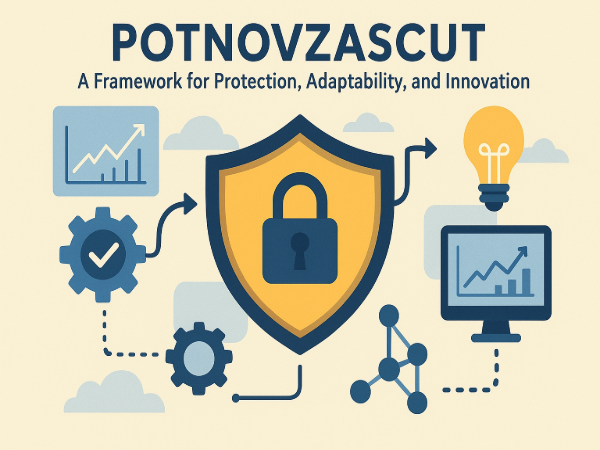About Potnovzascut: Unlocking the Future of Security, Adaptability, and System Innovation
A Comprehensive Guide to the Emerging Framework Reshaping Resilience and Digital Protection

About Potnovzascut is an emerging concept that integrates protection, adaptability, and innovation into a unified framework for modern systems. Blending advanced security strategies with dynamic design thinking, it emphasizes resilience, agility, and proactive risk management. Potnovzascut is used to describe forward-thinking security models as well as the study of anomalies and instability within complex environments, making it a powerful approach for organizations seeking to safeguard assets while enabling continuous improvement.
Introduction
In an age where digital threats, operational volatility, and rapid technological change dominate business landscapes, organizations need more than just static protection. They require systems capable of learning, adapting, and evolving in real time. Potnovzascut has emerged as a term representing that blend of security, adaptability, and creative resilience. While relatively new, its philosophy resonates with professionals seeking ways to keep operations secure while maintaining agility and room for innovation.
Potnovzascut offers a conceptual lens through which to examine the intersection of protective strategies, flexibility, and progressive design. This makes it relevant not only for cybersecurity experts but also for engineers, strategists, and leaders shaping the future of resilient infrastructure.
Origins and Evolution of Potnovzascut
The exact origin of the word “Potnovzascut” is still debated. Some consider it an amalgamation of ideas: “protection,” “novelty,” and “security.” Others suggest it was coined in speculative research papers discussing adaptive risk management. What matters more than its etymology is the intellectual environment in which it arose — one marked by:
Growing concerns over cyberattacks and digital espionage
The complexity of global supply chains
The need for systems to withstand unexpected failures or shocks
A push toward innovation even in high-risk environments
Initially, Potnovzascut appeared in niche discussions about designing self-healing systems. Over time, its meaning broadened to encompass strategies for balancing defense and evolution within enterprises and technical ecosystems.
Core Principles
The Potnovzascut framework rests on three foundational pillars:
Protection
Robust safeguards against threats are central. This includes encryption, access management, redundancy, and disaster-recovery protocols.
Adaptability
Static defenses quickly become obsolete. Potnovzascut stresses continuous learning, behavior monitoring, and adaptive response to emerging risks.
Innovation
Rather than limiting creativity, security can act as an enabler. Potnovzascut promotes experimentation within a controlled environment, ensuring progress without sacrificing safety.
Together, these pillars enable organizations to anticipate challenges and adjust to changing landscapes while maintaining structural integrity.
Potnovzascut and Security Innovation
Traditional security models focus on perimeter defenses and reactive incident management. Potnovzascut reimagines these boundaries. It supports:
Zero-trust architectures that verify every action
Behavior-based monitoring using advanced analytics
Decentralized defense mechanisms to prevent single points of failure
Predictive threat intelligence leveraging AI and machine learning
By merging advanced technology with proactive thinking, Potnovzascut turns security into an evolving discipline rather than a rigid rulebook.
Adaptability in the Potnovzascut Model
Adaptability is more than a buzzword; it is the heartbeat of Potnovzascut. Organizations adopting this mindset cultivate:
Responsive policies that update with new data
Modular infrastructure, allowing components to be replaced or upgraded with minimal disruption
Resilient teams trained to handle uncertainty and pivot strategies quickly
This flexibility empowers companies to navigate shifting markets, regulatory environments, and technological breakthroughs without compromising stability.
Exploring System Anomalies and Instability
One of the intriguing aspects of Potnovzascut is its dual identity. While it champions protection, it also invites the study of system anomalies and instability. These disruptions — such as sudden traffic spikes, hardware malfunctions, or software glitches — provide insights into vulnerabilities and opportunities for refinement.
Analyzing instability is essential to anticipate failures before they cascade into crises. Potnovzascut encourages organizations to build diagnostic tools that:
Detect irregular patterns early
Simulate adverse scenarios to test response plans
Use chaos engineering to strengthen resilience
Practical Applications Across Industries
Potnovzascut is not confined to cybersecurity alone. Its principles are versatile and apply across multiple sectors:
Healthcare: Protecting patient data while fostering telemedicine innovations
Finance: Enabling secure, adaptive fraud detection systems
Manufacturing: Supporting smart factories with automated monitoring and safety controls
Smart Cities: Designing resilient networks for transportation, utilities, and citizen services
Creative Industries: Balancing intellectual property protection with collaborative tools
The adaptability inherent in Potnovzascut enables these fields to embrace digital transformation safely.
Benefits and Competitive Advantages
Organizations adopting Potnovzascut can gain:
Enhanced resilience against cyber and operational risks
Sustainable innovation by embedding safety into experimental workflows
Optimized resource allocation, as systems prioritize critical tasks
Improved trust and reputation, particularly in data-sensitive markets
This synergy of protection and innovation fosters a sustainable competitive edge.
Challenges and Ethical Considerations
Despite its promise, Potnovzascut is not free from challenges:
Complexity: Designing adaptive systems can lead to over-engineering.
Ethics: Monitoring user behavior or using predictive models raises privacy questions.
Skills gap: Teams may require new expertise in adaptive risk management.
Costs: Developing resilient infrastructure demands long-term investment.
Addressing these concerns involves clear governance, ethical guidelines, and training to maintain transparency and fairness.
Future Outlook
As industries converge on connected platforms and intelligent systems, Potnovzascut is likely to mature into a formalized discipline. Emerging trends shaping its trajectory include:
Greater integration of AI-driven resilience
Expansion of autonomous security agents
Standardization of metrics to measure adaptability
Collaboration between regulators and innovators to define responsible practices
Organizations that start exploring Potnovzascut today may lead tomorrow’s resilient enterprises.
Steps to Implement Potnovzascut
For businesses aiming to adopt this framework, a strategic roadmap can help:
Assess Current Landscape – Identify critical assets, potential threats, and systemic weaknesses.
Define Goals – Align security and adaptability initiatives with organizational objectives.
Develop Architecture – Design modular systems and clear governance structures.
Invest in Analytics – Implement monitoring tools for early anomaly detection.
Encourage a Resilient Culture – Train staff to embrace change responsibly.
Iterate and Improve – Use feedback loops and testing to refine strategies over time.
Final Thoughts
Potnovzascut stands at the crossroads of security, adaptability, and system innovation. Though its definition continues to evolve, its essence lies in empowering organizations to safeguard assets while fostering progress. By understanding its principles, recognizing its challenges, and applying its insights, businesses can position themselves for success in an increasingly volatile and interconnected world.
Embracing Potnovzascut is not simply about defending against threats; it is about unlocking a mindset where protection and innovation coexist, guiding enterprises toward sustainable growth and resilience.



